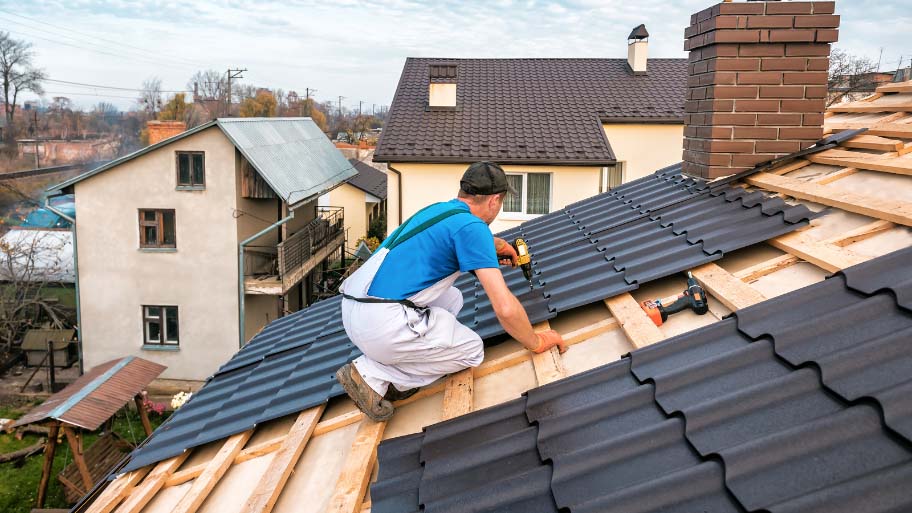Replacing your roof is a significant home improvement that can dramatically enhance your property’s appearance, energy efficiency, and overall value. However, this major undertaking requires careful preparation to ensure a smooth and successful installation. This guide will outline the essential steps to ready your home for a new roof, helping you minimize disruptions and protect your property during the construction process.
Planning and Timing
Proper planning is the cornerstone of any successful roof replacement project. Start by scheduling the work during a dry period to reduce the risk of rain damaging your home’s interior during the process. Depending on your region, certain seasons may be more suitable than others. For instance, late spring to early fall generally offers the most favourable weather conditions for roofing work, providing a reliable window for the project to proceed without weather-related interruptions. In Vancouver, where the climate can be unpredictable, choosing the right season is especially crucial. Vancouver roofing projects often benefit from careful timing to avoid the city’s frequent rain showers, which can pose challenges during installation.
Choosing a reputable roofing contractor is equally important. Look for a company with extensive experience in the type of roofing material you plan to use. Ask for references, read reviews, and verify that they are licensed and insured. A reliable contractor will guide you through the preparation process, offering insights and answering any questions you may have. They should provide a clear project timeline and explain how they plan to protect your property during the installation.
Indoor Preparation
Before the roofing work begins, it’s essential to protect the interior of your home. The vibrations caused by roofing activities can lead to objects shifting, falling, or becoming damaged. Start by removing or securing fragile items such as wall hangings, mirrors, and decorative pieces. Dust sheets can be used to cover furniture, safeguarding it against dust and debris that might infiltrate your home during the project.
The loft or attic is particularly vulnerable during a roof replacement. This area is directly beneath the roof, making it susceptible to falling debris and dust. Remove or cover any items stored in the loft to protect them from potential damage. If feasible, temporarily relocate these items to another part of your home or consider using a storage unit for the duration of the project.
Throughout your home, take extra precautions with delicate items like chandeliers, ceiling fans, and suspended decorations. These may require additional securing or temporary removal to avoid damage from vibrations. In some cases, it might be wise to consult with your contractor about any particularly vulnerable items.
Outdoor Preparation
The area surrounding your home will become an active work zone during the roof installation. Protecting this space is crucial to prevent damage to your property. Start by removing outdoor furniture, potted plants, and any decorative items that could be harmed by falling debris. If you have a pool or water feature, cover it securely to keep it clean and debris-free.
Tree branches and large shrubs near your roof should be trimmed back before the project begins. This not only allows the roofing team better access to your roof but also protects your garden from potential damage caused by falling debris. Overhanging branches can be particularly hazardous, so addressing them ahead of time is a wise precaution.
If you have satellite dishes or aerials mounted on your roof, make arrangements for their temporary removal and reinstallation after the roofing work is complete. This task may require coordination with your service provider, so plan accordingly to avoid service interruptions.
Garage and Driveway Preparation
The roofing team will need a secure space to store materials and park vehicles. If you have a garage, consider clearing it out to provide a safe area for overnight storage of roofing supplies. This also helps keep materials organized and protected from the elements. If you do not have a garage, designate a flat, accessible spot in your driveway or garden for this purpose.
During the roofing work, there’s a risk of falling debris damaging vehicles. To prevent this, move your cars, boats, or other vehicles away from the house or to a covered area. Even if your driveway seems like a safe distance, it’s better to err on the side of caution and relocate vehicles until the project is complete.
Utility Considerations
For safety, disconnect any electrical connections to exterior fixtures near the roofline. This may include security cameras, outdoor lighting, or holiday light installations. If you’re unsure how to safely disconnect these items, consult with an electrician. It’s better to take the time to do this properly than to risk electrical hazards during the roofing process.
If you have roof-mounted HVAC units, discuss with your contractor the best way to protect them during the roofing work. Depending on the situation, you might need to temporarily disconnect or cover these units to prevent damage. Some HVAC systems are particularly sensitive to dust and debris, so this step is essential to maintain their functionality.
Preparing for Noise and Disruption
Roof replacement is inherently noisy and can be disruptive to your daily routine. Being prepared for this will help you manage the stress of the project. Inform your neighbours about the upcoming work, providing them with the expected timeline. Apologize in advance for any noise or inconvenience, as this courtesy can help maintain good relations during the construction period.
Pets are often particularly sensitive to noise and disruptions. If possible, arrange for your pets to stay with a friend or at a boarding facility during the most disruptive parts of the project. If this isn’t feasible, create a quiet, safe space for them inside your home, away from the noise and commotion. Keeping pets calm and secure will reduce their stress and prevent accidents.
Safety Measures
Safety is a top priority during any construction project, especially when it comes to roof replacement. If you have children, it’s vital to explain the roofing process to them and set clear safety rules. Keep children and pets indoors during work hours, and ensure they understand the importance of staying away from work areas and equipment.
Work with your contractor to clearly define and mark off work zones around your home. This helps ensure the safety of both your family and the roofing crew. Use caution tape or temporary fencing to cordon off areas where materials will be stored or where debris might fall. Clear communication and clearly marked boundaries will go a long way in preventing accidents.
Documentation and Communication
Before work begins, document the current state of your home by taking detailed photographs of your exterior, including the roof, gutters, and surrounding landscape. These images can be invaluable for insurance purposes and can help ensure that any damage is properly addressed during the project. This step provides a clear record of your property’s condition before the roofing work begins, which can be crucial if any issues arise later.
Have a thorough discussion with your roofing contractor about the expected project timeline. Understanding the day-to-day schedule will help you plan your activities and minimize disruptions to your routine. Clear communication with your contractor is key to avoiding misunderstandings and ensuring that the project proceeds smoothly.
Post-Installation Preparation
Once the roof installation is complete, there are a few additional steps to ensure everything is in order. While reputable contractors will handle most of the cleanup, it’s wise to do a final sweep of your property. Check for small nails, debris, or other materials that might have been overlooked during the initial tidy-up. Taking the time to do this will ensure your property is safe and clean.
After the roofing work is finished, arrange for a final inspection with your contractor. This is your opportunity to review the work, ask any remaining questions, and ensure you’re satisfied with the results. Pay close attention to the details during this inspection, as it’s your last chance to address any concerns before making the final payment.
Finally, consider setting up a regular maintenance schedule for your new roof. While your new roof is built to last, regular inspections and maintenance will help you catch potential issues early and extend its lifespan. Discuss with your contractor any specific maintenance needs for the type of roofing material used and plan accordingly.
Summary
Preparing for a new roof installation may seem daunting, but with proper planning and attention to detail, you can ensure a smooth and successful project. By taking these preparatory steps, you’re not only protecting your property, but also contributing to the efficiency and effectiveness of the roofing process. From planning and timing to safety measures and post-installation care, each step plays a crucial role in the overall success of your roof replacement. Your new roof is a significant investment in your home’s future, and by preparing properly, you can ensure that this investment pays off for years to come.









